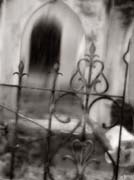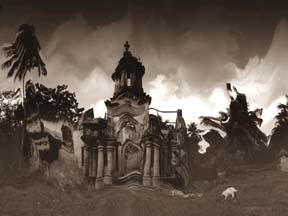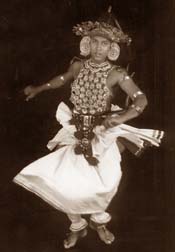
A journey from desolation to hope
  QUEST: Anoma Wijewardene provides a multi-media tour de force with
her current exhibition Quest. The exhibition combines digital art with
provocative words, music, performance and video installation. QUEST: Anoma Wijewardene provides a multi-media tour de force with
her current exhibition Quest. The exhibition combines digital art with
provocative words, music, performance and video installation.
Quest offers "a glimpse of what is possible if we work toward peace
and healing." Quest will be exhibited for a short time only at The
National Art Gallery from June 2 to 4 daily from 10 am to 6 pm.
Admission will be free.
Quest, which has been three years in the making, is the
internationally recognized artist's first exhibition of Digital Art.
The installation stems from Anoma's travels throughout Sri Lanka,
from Jaffna to Matara to Colombo, and depicts the struggles of ordinary
Sri Lankans in the face of both natural and man-made disasters. Some of
the images have barely been altered.
Others are layered, fused, blurred, and sharpened. Quotes from
philosophers, politicians, authors and ordinary citizens create a
dialogue with the images. The quotes are in all three languages. Within
an adjoining space, a multi screen video installation incorporating
performance art is on continuous display.
 Shoals of fish swimming through the every day lives of a tsunami
refugee camp is surreal, but only until the mind encompasses the reality
of lives and memories that are forever submerged; an image that
instantly succeeds in conveying the extent to which even the lives of
the living were engulfed. Shoals of fish swimming through the every day lives of a tsunami
refugee camp is surreal, but only until the mind encompasses the reality
of lives and memories that are forever submerged; an image that
instantly succeeds in conveying the extent to which even the lives of
the living were engulfed.
As, predicted in the Hindu Vedas, the Kali Yuga now rages through our
lives and Kali, the Goddess of Destruction, smites and humbles us with
... Fire, Wind and Water! Natural disasters accelerate the statistics,
but the hand of man makes constant, steady progress with wars for power.
The world over, humanity is confronted with violence and loss to the
extent that, no longer is the source relevant, be it natural or man-
made! What is now relevant is, if we choose to accept our individual
responsibility to yearn for a better world or if we stumble on,
desensitized?
Brightly dressed children in lives accustomed to blasted-out,
roofless churches...columns blurred, reaching upwards towards a serenity
which was once an accepted norm.
With high tech tools in hand, Anoma Wijewardene has first, simply,
photographed Sri Lanka. It is then that, her work has begun: exploring
digital technology as a new medium for her work, Anoma who has exhibited
extensively, with solo exhibitions in Sydney, Kuala Lumpur and New Delhi
as well as in Colombo, now presents what is undeniably, her most
powerful message.
In stark contrast to her previous perspective of, veil upon veil of
mixed medium that led the eye into a deep vortex of visions, the new
imagery is immediate.
With her highly trained artistic skills she has manipulated colours,
forms and lines to offer an opportunity for humanity to better
understand, our place in this time.
 Deliberately selecting images that are not blatantly dramatic, Anoma
has instead, used a subtle approach with images that tend to seep in and
lodge, to portray the remains of great destruction: desolation and
despair, twisting and turning in a journey that travels, inexorably
towards the light that is... Hope! Manipulated elements in the primary
source then, aid the viewer to immediately identify the deep desolation
that resides beneath the thin skin of social expectation. Deliberately selecting images that are not blatantly dramatic, Anoma
has instead, used a subtle approach with images that tend to seep in and
lodge, to portray the remains of great destruction: desolation and
despair, twisting and turning in a journey that travels, inexorably
towards the light that is... Hope! Manipulated elements in the primary
source then, aid the viewer to immediately identify the deep desolation
that resides beneath the thin skin of social expectation.
The absence of emotion of the woman who holds a child and sits
outside the remains of her home becomes persistent in the viewers mind
as the background is digitally misaligned, enhancing the turmoil of her
life.
The journey is narrated. Images are untitled but are exhibited like
beads in a chain, linked by quotations from a host of scholars,
dreamers, artists and politicians.
People as the key stakeholders must be encouraged to participate in
the reconciliation process
- Jayantha Dhanapala
Endorsing the vitality of national responsibility for our future;
endorsing the need for commitment from every quarter, every walk of
life, to ensure peace. The importance of exhausting every avenue to
build a peaceful world....
The more we sweat in peace the less we bleed in war
-Vijaya Lakshmi Pundit
The intelligentsia condemns war and the politics of selfishness that
still persists.
"Tsunamis may wipe out people and villages but they do not wipe out
political boundaries...the power struggle did not get subsumed beneath
the waves ..." Jehan Perera.
Through the despair and destruction, against all odds, the
progression to the human ability to hope, always seems to surface.
Despite the efforts of the greedy and the unwise, the signs of divine
existence, the intangible that sustains hope is, constantly documented.
Anoma's discipline in harnessing the artists' infinite, imaginative
inclination to create a realistic plane is admirable.
To doggedly adhere to her objective of, offering her people a tool to
measure the aftermath of modern Sri Lanka's two greatest disasters, the
Civil War and the Tsunami, is an achievement.
To carry a country's experience of grief and pain until she arrives
at the thresh hold of a hope filled future is, a service that needs to
be rendered by many more!
Since wars begin in the minds of men,
It is in the minds of men that the defenses of peace must be
constructed
Preamble of the UNESCO constitution
Serenity in the face of Indrani a Sinhalese from Galle, who Anoma
photographed beside her Tamil husband, in their shop in Jaffna... of an
image of Hope! (Enhanced to exhibit expressions in the foreground,
against a faded background)
"Another world is not only possible, she is on her way...." Arundhati
Roy
The exhibition is a panoramic view of the Sri Lankan journey from
Desolation to Hope.
- Sunela Jayewardene
The costume of the Kandyan Ves dancer
Rohan L. JAYATILLEKE
 TRADITION: With the passage of time, due to economic reasons and also
the absence of a funding and promoting agency in the field of Kandyan
dancing, the costume of the Kandyan dancer too has degenerated to a
certain extent. TRADITION: With the passage of time, due to economic reasons and also
the absence of a funding and promoting agency in the field of Kandyan
dancing, the costume of the Kandyan dancer too has degenerated to a
certain extent.
In this scenario, it is relevant to record the original outfit of a
Kandyan Ves dancer in order that the Ministry of National Heritage and
Culture would address their minds to rectify the shortcomings.
The costume and the ornaments of a Kandyan dancer are collectively
referred to as Su-seta Abharana (sixty-four ornaments) the tradition
being a replica of the ceremonial regalia of the mythical King of
Malayadesa (South India) of the legend of Kohomba Kankariya.
This is the dress of the Ves dancer, the pre-eminent dancer, and the
highest achievement of a dancer, who is debarred after his ceremonial
investor never to dance sans this Ves costume, as he is regarded as the
king of the field of Kandyan dancing.
The most striking feature of the Ves dancer is his head-gear, a
composted crown on inter-connected parts, a semi-circular silver tiara,
Sikha Bhandanaya, the Nalal Hede or Netti Malaya, the bow shaped
forehead plate, fringed with an array of Bodhi leaves, payim potha seven
silver spokes rising like rays over-topping the crown, the stylized
Jatava of carved wood, immediately behind and the Jata patiya (Jata rala),
the long embroidered ribbon, about 45 inches long trailing down from the
top of the Jatava down to the dancer's back.
The ears are bordered with elaborately carved Todu patti. The
shoulders are covered with Ura bahu. Three sets of bangles, Bandi Valalu,
ornament the arms, six on each. Necklaces of coloured heads closely
encircle the neck.
Ornamenting the chest is the avul hera, spreading from an ornamented
ivory disc over the chest, are eight sets of coloured strands of beads
of four strings each. Four of these, two on either side, tied at the
back encircle the bare torso.
Above the shoulder and running round the neck are two strings of
beads. At their point of intersection of two sets of beaded strings, is
a boss of ivory or buffalo horn decorated with silver.
The concentric circles of shining floral designs with petal spreading
from a central boss of ivory, three such sets of flowers, one central
and one on either side, cover the broad chest.
Extending from the waist down to the ankle is the pleated white
cloth, the uludaya; the full length of this is about three and half
yards. Over this is another heavily pleated half-cloth about 32 inches
broad and no less than 20 yards long right up to the knees.
Finally the yoth pota, another cloth of very thin texture folded
several times to the width of about 2 inches, round the waist with the
ends flounced to form the neriya. A silver ornamented belt with a richly
ornamented clasp, the bubulu patiya about three to four inches broad is
worn above the clothes.
Extending from the centre of this belt right up to the knees is, the
inahediya usually made of glossy velvet or satin silkand decorated with
silver bosses.
Around the cleaves are worn the rasupati, two pieces of leather with
several sets of brass jingles attached to them.
On the feet are worn the silambu, anklets attached to the second toe
with strings. Incidentally the first lady to have been honoured as a Ves
dancer was late Mirian Pieris (daughter of Sir Paul E. Pieris, after
marriage de Seram, mother of the world famous cellist Rohan de Saram and
pianist Druvi de Saram (both settled in England now) many decades ago,
when she was a student of Hillwood College, Kandy.
It was Hillwood College that initiated girls to Kandyan dancing and
also introduced the lama saree half saree for girls.
(Source: Sri M. D. Raghavan (Indian national), Sinha;
a Natum (Colombo 1965)
(The writer is a member of the Bhratiya Kala Kendra)
|


